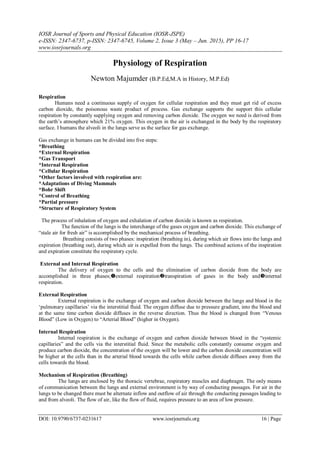
Physiology of Respiration Process in Five Steps
- 1. IOSR Journal of Sports and Physical Education (IOSR-JSPE) e-ISSN: 2347-6737, p-ISSN: 2347-6745, Volume 2, Issue 3 (May – Jun. 2015), PP 16-17 www.iosrjournals.org DOI: 10.9790/6737-0231617 www.iosrjournals.org 16 | Page Physiology of Respiration Newton Majumder (B.P.Ed,M.A in History, M.P.Ed) Respiration Humans need a continuous supply of oxygen for cellular respiration and they must get rid of excess carbon dioxide, the poisonous waste product of process. Gas exchange supports the support this cellular respiration by constantly supplying oxygen and removing carbon dioxide. The oxygen we need is derived from the earth‟s atmosphere which 21% oxygen. This oxygen in the air is exchanged in the body by the respiratory surface. I humans the alveoli in the lungs serve as the surface for gas exchange. Gas exchange in humans can be divided into five steps: *Breathing *External Respiration *Gas Transport *Internal Respiration *Cellular Respiration *Other factors involved with respiration are: *Adaptations of Diving Mammals *Bohr Shift *Control of Breathing *Partial pressure *Structure of Respiratory System The process of inhalation of oxygen and exhalation of carbon dioxide is known as respiration. The function of the lungs is the interchange of the gases oxygen and carbon dioxide. This exchange of “stale air for fresh air” is accomplished by the mechanical process of breathing. Breathing consists of two phases: inspiration (breathing in), during which air flows into the lungs and expiration (breathing out), during which air is expelled from the lungs. The combined actions of the inspiration and expiration constitute the respiratory cycle. External and Internal Respiration The delivery of oxygen to the cells and the elimination of carbon dioxide from the body are accomplished in three phases;external respirationtranspiration of gases in the body andinternal respiration. External Respiration External respiration is the exchange of oxygen and carbon dioxide between the lungs and blood in the „pulmonary capillaries‟ via the interstitial fluid. The oxygen diffuse due to pressure gradient, into the blood and at the same time carbon dioxide diffuses in the reverse direction. Thus the blood is changed from “Venous Blood” (Low in Oxygen) to “Arterial Blood” (higher in Oxygen). Internal Respiration Internal respiration is the exchange of oxygen and carbon dioxide between blood in the “systemic capillaries” and the cells via the interstitial fluid. Since the metabolic cells constantly consume oxygen and produce carbon dioxide, the concentration of the oxygen will be lower and the carbon dioxide concentration will be higher at the cells than in the arterial blood towards the cells while carbon dioxide diffuses away from the cells towards the blood. Mechanism of Respiration (Breathing) The lungs are enclosed by the thoracic vertebrae, respiratory muscles and diaphragm. The only means of communication between the lungs and external environment is by way of conducting passages. For air in the lungs to be changed there must be alternate inflow and outflow of air through the conducting passages leading to and from alveoli. The flow of air, like the flow of fluid, requires pressure to an area of low pressure.
- 2. Physiology Of Respiration DOI: 10.9790/6737-0231617 www.iosrjournals.org 17 | Page Since the atmospheric is relatively constant, creation of pressure gradient depends upon the intrapulmonic pressure being alternately lower and higher than atmospheric pressure. This is accomplished by changing the size (volume) of the thoracic cavity and consequently the intrapulmonic pressure. It is achieved through the combined action of the main respiratory muscles, the diaphragm and external intercostals when the thoracic pressure is lowered, and the pressure on the lungs is decreased conversely. When the thoracic volume is reduced, the intrathoracic pressure is raised, and the pressure on the lung is increased. Inspiration When the diaphragm and external intercostals muscles contract, quiet inspiration begins. As the dome shaped diaphragm flattens, it descends into the abdominal cavity and the thoracic volume is increased from top to bottom. At the same time contraction of the external intercostals muscle raises the ribs upward and outward. So the thoracic cavity is increased from front to back and side to side. As the thoracic volume increases, the intrathoracic pressure gradient is created between atmosphere and alveoli and the air rushes into the lungs until the intrathoracic pressure equals atmospheric pressure. Expiration During expiration, the events are just opposite of those in inspiration. The diaphragm and external intercostals muscles relax and return to their original position. As a result, the thoracic volume is decreased, and the pressure on the lungs is increased. The elastic tissue of the lungs, stretched on inspiration, now recoils, and the lungs shrink back. The intrapulmonic pressure and air is forced out of the lungs. During forceful expiration the abdominal muscles (Rectus abdominus and oblique muscles) and internal intercostals muscles increases intra- abdominal pressure. So the diaphragm is pushed upward. Contraction of internal intercostals pulls the ribs downward and inward, just opposite to the action of external intercostals.
